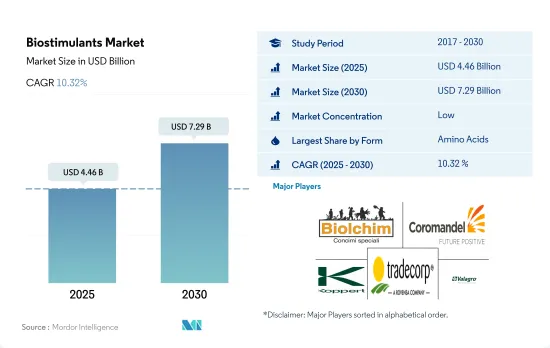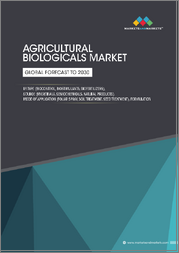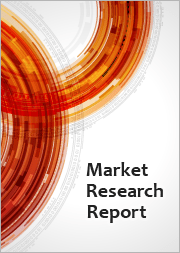
|
시장보고서
상품코드
1685909
생물촉진제 : 시장 점유율 분석, 산업 동향 및 통계, 성장 예측(2025-2030년)Biostimulants - Market Share Analysis, Industry Trends & Statistics, Growth Forecasts (2025 - 2030) |
||||||
생물촉진제 시장 규모는 2025년에 44억 6,000만 달러에 달할 것으로 추정됩니다. 2030년에는 72억 9,000만 달러에 이를 것으로 예상되며, 예측 기간 중(2025-2030년) CAGR은 10.32%를 나타낼 것으로 전망됩니다.

- 농업에서의 생물촉진제의 사용은 최근 기세를 늘리고 있으며, 작물의 성장과 수율에 대한 생물촉진제 제품의 이점에 대한 농가의 의식이 높아지고 있습니다. 생물촉진제는 식물의 성장을 가속하고 영양 흡수, 스트레스 내성, 건강 전반을 향상시키는 천연 또는 합성 물질입니다.
- 아미노산은 세계에서 가장 소비되는 생물촉진제로 부상했으며, 2022년 시장 점유율은 32.0%였습니다. 이 높은 점유율은 주로 유럽 국가의 겨울 밀 작물에서 종자 수율과 귀당 곡물 수를 증가시키는 등 아미노산을 살포하면 작물에 좋은 영향을 미치기 때문입니다. 생물촉진제의 소비는 연작작물에서 가장 많았고, 2022년 시장 점유율의 74.6%를 차지했으며, 원예 작물, 환금 작물이 뒤를 이었습니다.
- 생물촉진제 분야는 유럽이 압도적이었고, 2022년 시장 점유율은 40.6%이었으며 이어 북미, 아시아태평양이었습니다. 이 높은 점유율은 이 지역의 농가의 의식이 높고 정부가 2030년까지 농지의 25.0%를 유기농업으로 만든다는 목표를 내세워 유기농업을 추진하고 있기 때문입니다.
- 생물촉진제 분야는 유기 제품에 대한 수요 증가와 유기 작물 재배 면적 증가에 견인되어 2023년부터 2029년에 걸쳐 CAGR 10.1%를 나타낼 것으로 예상됩니다.
- 생물촉진제는 화학 비료와 농약의 사용을 줄이기 위해 농업 업계에서 인기를 얻고 있습니다. 건전한 속도로 성장하고 있는 유기식품산업도 생물촉진제 시장의 성장을 지지하는 큰 원동력이 되고 있습니다.
- 유럽은 세계의 생물촉진제 최대 시장이며, 2022년에는 13억 달러로 평가되어 시장 매출의 40.6%를 차지했습니다. 유럽위원회는 회원국들이 각 농지의 25%를 유기농업으로 전환시키는 목표를 세우고 있으며, 바이오기반 경제를 위한 스마트한 성장과 혁신이라는 유럽의 중요한 우선 과제를 강화하고 있습니다. 생물촉진제는 그를위한 중요한 원료입니다. 독일은 생물촉진제의 효과를 높이기 위한 연구개발에 투자함으로써 이러한 목표 달성에 주도적인 역할을 하고 있습니다.
- 북미는 세계의 생물촉진제 시장에서 2위 시장이며, 2022년 시장 규모는 8억 4,020만 달러였습니다. 이 지역의 국가들은 유기농업을 늘리는 정책을 도입하고 있으며, 미국에서는 2022년에 3억 달러를 투자하는 USDA의 유기농업이행 이니셔티브(Organic Transition Initiative)가 있었습니다. 이 이니셔티브는 농부들에게 자금 지원을 하고 생물촉진제의 유익한 영향에 대한 인식을 높이는 등 농부들 간의 지도를 장려하기 위한 것입니다.
- 아시아태평양은 생물촉진제 시장에서 3위를 차지하고 있으며, 세계 최대의 비료 소비국인 중국은 이미 작물 생산에 유기 투입물을 사용하고 있습니다. 마찬가지로 남미와 아프리카도 생산자의 의식이 높아짐에 따라 생물촉진제 시장의 변화를 목격하고 있습니다. 화학 투입물의 사용량 삭감과 세계의 유기 재배 면적 증가는 예측 기간 동안 CAGR 10.1%로 생물촉진제 시장을 견인할 것으로 예상됩니다.
세계의 생물촉진제 시장 동향
의식 증가와 정부의 이니셔티브는 북미와 유럽의 유기 생산을 촉진하고 있습니다.
- 유기농업은 지속가능한 식량시스템에 크게 공헌하는 것으로 대두되어 세계 187개국에서 실천되고 있습니다. 2021년 기준 세계의 유기농지는 7,230만 헥타르로, 2018년부터 2021년에 걸쳐 전 지역에서 평균 2.9% 증가했습니다. 이 중 2021년 유기경지 면적은 1,440만 헥타르로 유기농지 전체의 19.9%를 차지했습니다. 유기농업의 최강시장은 북미와 유럽으로 2022년 세계 유기경지면적의 41.0%를 차지했습니다. 유럽의 유기 경작지는 2022년에는 650만 헥타르로 전체 유기 경작지의 44.1%에 해당하는 수치였습니다. 북미와 유럽에서 유기 재배되는 가장 중요한 작물은 사과, 딸기, 곡물, 올리브 등입니다.
- 아시아태평양의 신흥 국가들은 또한 유기농업운동에 참여하며 국내 수요를 충족하는 신선한 유기농산물의 생산과 공급으로 자급자족하고 있습니다. 아시아태평양에서는 유기농업 증가 경향을 보였으며, 2017-2022년까지 유기경지 면적은 18.8% 증가했습니다. 이 지역 정부의 주요 이니셔티브도 유기농 농업을 뒷받침하는 데 중요한 역할을합니다. 예를 들어, 일본의 2021년 농업·경영 기본계획은 2030년까지 유기농업자수와 유기경지수를 3배로 늘리는 것을 목표로 하고 있습니다.
- 유기농업은 세계적으로 인기가 높아지고 있으며, 지속가능한 식량시스템을 실현하기 위해 다양한 국가가 유기농업을 채용하고 있습니다. 유기농업의 성장의 원동력이 되고 있는 것은 토양의 건전성을 촉진하고, 환경에 대한 영향을 저감하고, 보다 건강한 식품을 생산하는 등 유기농업의 이점에 대한 의식의 높아입니다.
유기농 식품의 1인당 지출은 주로 미국과 독일에서 관찰되지만, 이는 보다 건강하고 지속 가능한 식품에 대한 소비자 수요에 기인합니다.
- 유기농 식품 시장은 지난 10년간 현저한 성장을 거두었으며, 세계 매출은 2012년 708억 달러에서 2020년 1,206억 달러에 이르렀습니다. 유기농 식품에 대한 추세는 보다 건강하고 지속가능한 식품 선택을 추구하는 소비자 수요 증가와 전통적인 농업이 환경에 미치는 영향에 대한 의식이 증가하는 등 여러 요인들에 힘입어지고 있습니다.
- 유기농 무역협회가 실시한 조사에 따르면 2021년 유기농 과일 및 채소 매출은 같은 해 약 4.5% 증가하여 전체 유기농 매출의 15%를 차지했습니다. 유기농 제품에 대한 평균 지출액은 현재 북미가 시장을 독점하고 있으며, 미국 1인당 지출액은 2021년에 186.7달러에 이르렀고, 북미 국가 중 가장 높았습니다. 유럽도 유기농 시장에서 크게 성장했으며, 같은 해 1인당 지출액이 가장 높은 것은 독일에서 75.6달러였습니다.
- 유기 식품 시장은 가처분 소득이 높은 선진국들이 여전히 지배적이지만 신흥 국가에서도 성장이 예상됩니다. 예를 들어 아시아태평양에서는 노동계급 증가가 시장 확대에 기여할 것으로 보입니다. 유기농 제품의 가용성이 높아짐에 따라 가격도 저렴합니다.
- 유기농 식품 시장은 세계적으로 큰 성장을 이루고 있으며, 예측 기간 동안에도 계속될 것으로 예상됩니다.
생물촉진제 산업 개요
생물촉진제 시장은 세분화되어 상위 5개사에서 11.95%를 차지하고 있습니다. 이 시장 주요 기업은 다음과 같습니다. Biolchim SpA, Coromandel International Ltd, Koppert Biological Systems Inc., Trade Corporation International and Valagro(알파벳순 정렬).
기타 혜택
- 엑셀 형식 시장 예측(ME) 시트
- 3개월의 애널리스트 서포트
목차
제1장 주요 요약과 주요 조사 결과
제2장 보고서 제안
제3장 소개
- 조사의 전제조건과 시장 정의
- 조사 범위
- 조사 방법
제4장 주요 산업 동향
- 유기 재배 면적
- 1인당 유기농 제품에 대한 지출
- 규제 프레임워크
- 아르헨티나
- 호주
- 브라질
- 캐나다
- 중국
- 이집트
- 프랑스
- 독일
- 인도
- 인도네시아
- 이탈리아
- 일본
- 멕시코
- 네덜란드
- 나이지리아
- 필리핀
- 러시아
- 남아프리카
- 스페인
- 태국
- 터키
- 영국
- 미국
- 베트남
- 밸류체인과 유통채널 분석
제5장 시장 세분화
- 형태
- 아미노산
- 풀빅산
- 휴믹산
- 단백질 가수분해물
- 해조류 추출물
- 기타 생물촉진제
- 작물 유형
- 환금 작물
- 원예 작물
- 경작 작물
- 지역
- 아프리카
- 국가별
- 이집트
- 나이지리아
- 남아프리카
- 기타 아프리카
- 아시아태평양
- 국가별
- 호주
- 중국
- 인도
- 인도네시아
- 일본
- 필리핀
- 태국
- 베트남
- 기타 아시아태평양
- 유럽
- 국가별
- 프랑스
- 독일
- 이탈리아
- 네덜란드
- 러시아
- 스페인
- 터키
- 영국
- 기타 유럽
- 중동
- 국가별
- 이란
- 사우디아라비아
- 기타 중동
- 북미
- 국가별
- 캐나다
- 멕시코
- 미국
- 기타 북미
- 남미
- 국가별
- 아르헨티나
- 브라질
- 기타 남미
- 아프리카
제6장 경쟁 구도
- 주요 전략 동향
- 시장 점유율 분석
- 기업 상황
- 기업 프로파일
- Agriculture Solutions Inc.
- Agrinos
- Atlantica Agricola
- Biolchim SpA
- Bionema
- Coromandel International Ltd
- Haifa Group
- Koppert Biological Systems Inc.
- Plant Response Biotech Inc.
- Sigma Agriscience LLC
- T Stanes and Company Limited
- Trade Corporation International
- UPL
- Valagro
- Vittia Group
제7장 CEO에 대한 주요 전략적 질문
제8장 부록
- 세계 개요
- 개요
- Five Forces 분석 프레임워크
- 세계의 밸류체인 분석
- 시장 역학(DROs)
- 정보원과 참고문헌
- 도표 일람
- 주요 인사이트
- 데이터 팩
- 용어집
The Biostimulants Market size is estimated at 4.46 billion USD in 2025, and is expected to reach 7.29 billion USD by 2030, growing at a CAGR of 10.32% during the forecast period (2025-2030).

- The use of biostimulants in agriculture has gained momentum in recent years, with increasing awareness among farmers about the benefits of these products on crop growth and yield. Biostimulants are natural or synthetic substances that enhance plant growth and improve nutrient uptake, stress tolerance, and overall health.
- Amino acids emerged as the most consumed biostimulants globally, with a market share of 32.0% in 2022. This high share was primarily due to the positive effects of amino acids on crops when applied, such as increasing seed yield and grain numbers per ear in winter wheat crops in European countries. The consumption of biostimulants was the highest in row crops, which accounted for 74.6% of the market share in 2022, followed by horticultural crops and cash crops.
- Europe dominated the biostimulants segment, with a market share of 40.6% in 2022, followed by North America and Asia-Pacific. This high share was due to the high awareness among farmers in the region and the government's promotion of organic agriculture, with a target of 25.0% of agricultural land to be organic by 2030.
- The biostimulants segment is expected to record a CAGR of 10.1% between 2023 and 2029, driven by the increasing demand for organic products and the growing area under the cultivation of organic crops.
- Biostimulants have gained popularity in the agricultural industry to reduce the use of chemical fertilizers and pesticides. The organic food industry, which is growing at a healthy rate, is another major driving force behind the growth of the biostimulant market.
- Europe is the largest market for global biostimulants, accounting for 40.6% of the market value, valued at USD 1.3 billion, in 2022. The European Commission has set a target for member countries to bring 25% of their respective agricultural land under organic farming, reinforcing Europe's key priorities for smart growth and innovation for the bio-based economy. Biostimulants represent a critical ingredient for the same. Germany plays a lead role in achieving these objectives by investing in R&D to enhance the effectiveness of biostimulants.
- North America is the second-largest market for global biostimulants, with a market value of USD 840.2 million in 2022. Countries in the region are introducing policies to increase organic farming, such as the USDA's Organic Transition Initiative in the United States, with an investment of USD 300 million in 2022. This initiative aims to provide financial assistance to farmers and encourage farmer-to-farmer mentoring, including creating awareness of the beneficial impacts of biostimulants.
- The Asia-Pacific region holds the third-largest position in the biostimulants market, with China, the world's largest fertilizer consumer, already using organic inputs for crop production. Similarly, South America and Africa have also witnessed a flux in the biostimulants market due to increased awareness among growers. The reduced usage of chemical inputs and increasing global organic area are projected to drive the biostimulants market at a CAGR of 10.1% during the forecast period.
Global Biostimulants Market Trends
The increasing awareness and Government initiatives is driving the organic production in North America and Europe.
- Organic agriculture has emerged as a significant contributor to sustainable food systems, with 187 countries practicing it globally. As of 2021, there are 72.3 million hectares of organic agricultural land globally, with an average increase of 2.9% across all regions from 2018 to 2021. Among these, organic arable land accounted for 14.4 million hectares in 2021, representing 19.9% of the total organic agricultural land. The strongest markets for organic farming are in North America and Europe, accounting for 41.0% of the global organic arable land in 2022. The total organic arable land in Europe was 6.5 million hectares in 2022, equivalent to 44.1% of the overall organic arable agricultural area. The most significant crops grown organically in North America and Europe are apples, strawberries, cereals, and olives, among others.
- Developing countries in the Asia-Pacific region are also joining the organic agriculture movement and becoming self-sufficient in producing and providing fresh organic produce to meet domestic demand. The Asia-Pacific region observed an increasing trend in organic farming, with an 18.8% increase in organic arable land from 2017 to 2022. The major initiatives by governments in the region have also played a vital role in boosting organic farming. For example, Japan's Basic Plan for Agriculture and Management in 2021 aims to triple the number of organic farmers and organic lands by 2030.
- Organic agriculture is becoming increasingly popular globally, with various countries adopting it to achieve sustainable food systems. The growth in organic agriculture is driven by the increasing awareness about the benefits of organic farming, such as promoting soil health, reducing environmental impacts, and producing healthier food.
Per capita spending of organic food majorly observed in United States and Germany, attributed to the consumer demand for healthier and sustainable food
- The organic food market has experienced significant growth over the past decade, with global sales reaching USD 120.6 billion in 2020, up from USD 70.8 billion in 2012. The trend toward organic food is driven by several factors, including increasing consumer demand for healthier, more sustainable food options and growing awareness about the environmental impact of conventional agriculture.
- According to a survey conducted by the Organic Trade Association, in 2021, sales of organic fruits and vegetables increased by around 4.5% that year, accounting for 15% of the overall organic sales. North America currently dominates the market in terms of average spending on organic products, with per capita spending in the United States reaching USD 186.7 in 2021, the highest among North American countries. Europe is also expected to experience significant growth in the organic market, with Germany accounting for the highest per capita spending of USD 75.6 during the same year.
- While the organic food market is still dominated by developed countries with high levels of disposable income, it is also expected to grow in developing nations. For example, in the Asia-Pacific region, the increase in the number of working-class people is likely to contribute to market expansion. As the availability of organic products increases, prices become more affordable.
- The organic food market is experiencing significant growth globally and is expected to continue during the forecast period.
Biostimulants Industry Overview
The Biostimulants Market is fragmented, with the top five companies occupying 11.95%. The major players in this market are Biolchim SpA, Coromandel International Ltd, Koppert Biological Systems Inc., Trade Corporation International and Valagro (sorted alphabetically).
Additional Benefits:
- The market estimate (ME) sheet in Excel format
- 3 months of analyst support
TABLE OF CONTENTS
1 EXECUTIVE SUMMARY & KEY FINDINGS
2 REPORT OFFERS
3 INTRODUCTION
- 3.1 Study Assumptions & Market Definition
- 3.2 Scope of the Study
- 3.3 Research Methodology
4 KEY INDUSTRY TRENDS
- 4.1 Area Under Organic Cultivation
- 4.2 Per Capita Spending On Organic Products
- 4.3 Regulatory Framework
- 4.3.1 Argentina
- 4.3.2 Australia
- 4.3.3 Brazil
- 4.3.4 Canada
- 4.3.5 China
- 4.3.6 Egypt
- 4.3.7 France
- 4.3.8 Germany
- 4.3.9 India
- 4.3.10 Indonesia
- 4.3.11 Italy
- 4.3.12 Japan
- 4.3.13 Mexico
- 4.3.14 Netherlands
- 4.3.15 Nigeria
- 4.3.16 Philippines
- 4.3.17 Russia
- 4.3.18 South Africa
- 4.3.19 Spain
- 4.3.20 Thailand
- 4.3.21 Turkey
- 4.3.22 United Kingdom
- 4.3.23 United States
- 4.3.24 Vietnam
- 4.4 Value Chain & Distribution Channel Analysis
5 MARKET SEGMENTATION (includes market size in Value in USD and Volume, Forecasts up to 2030 and analysis of growth prospects)
- 5.1 Form
- 5.1.1 Amino Acids
- 5.1.2 Fulvic Acid
- 5.1.3 Humic Acid
- 5.1.4 Protein Hydrolysates
- 5.1.5 Seaweed Extracts
- 5.1.6 Other Biostimulants
- 5.2 Crop Type
- 5.2.1 Cash Crops
- 5.2.2 Horticultural Crops
- 5.2.3 Row Crops
- 5.3 Region
- 5.3.1 Africa
- 5.3.1.1 By Country
- 5.3.1.1.1 Egypt
- 5.3.1.1.2 Nigeria
- 5.3.1.1.3 South Africa
- 5.3.1.1.4 Rest of Africa
- 5.3.2 Asia-Pacific
- 5.3.2.1 By Country
- 5.3.2.1.1 Australia
- 5.3.2.1.2 China
- 5.3.2.1.3 India
- 5.3.2.1.4 Indonesia
- 5.3.2.1.5 Japan
- 5.3.2.1.6 Philippines
- 5.3.2.1.7 Thailand
- 5.3.2.1.8 Vietnam
- 5.3.2.1.9 Rest of Asia-Pacific
- 5.3.3 Europe
- 5.3.3.1 By Country
- 5.3.3.1.1 France
- 5.3.3.1.2 Germany
- 5.3.3.1.3 Italy
- 5.3.3.1.4 Netherlands
- 5.3.3.1.5 Russia
- 5.3.3.1.6 Spain
- 5.3.3.1.7 Turkey
- 5.3.3.1.8 United Kingdom
- 5.3.3.1.9 Rest of Europe
- 5.3.4 Middle East
- 5.3.4.1 By Country
- 5.3.4.1.1 Iran
- 5.3.4.1.2 Saudi Arabia
- 5.3.4.1.3 Rest of Middle East
- 5.3.5 North America
- 5.3.5.1 By Country
- 5.3.5.1.1 Canada
- 5.3.5.1.2 Mexico
- 5.3.5.1.3 United States
- 5.3.5.1.4 Rest of North America
- 5.3.6 South America
- 5.3.6.1 By Country
- 5.3.6.1.1 Argentina
- 5.3.6.1.2 Brazil
- 5.3.6.1.3 Rest of South America
- 5.3.1 Africa
6 COMPETITIVE LANDSCAPE
- 6.1 Key Strategic Moves
- 6.2 Market Share Analysis
- 6.3 Company Landscape
- 6.4 Company Profiles (includes Global Level Overview, Market Level Overview, Core Business Segments, Financials, Headcount, Key Information, Market Rank, Market Share, Products and Services, and Analysis of Recent Developments).
- 6.4.1 Agriculture Solutions Inc.
- 6.4.2 Agrinos
- 6.4.3 Atlantica Agricola
- 6.4.4 Biolchim SpA
- 6.4.5 Bionema
- 6.4.6 Coromandel International Ltd
- 6.4.7 Haifa Group
- 6.4.8 Koppert Biological Systems Inc.
- 6.4.9 Plant Response Biotech Inc.
- 6.4.10 Sigma Agriscience LLC
- 6.4.11 T Stanes and Company Limited
- 6.4.12 Trade Corporation International
- 6.4.13 UPL
- 6.4.14 Valagro
- 6.4.15 Vittia Group
7 KEY STRATEGIC QUESTIONS FOR AGRICULTURAL BIOLOGICALS CEOS
8 APPENDIX
- 8.1 Global Overview
- 8.1.1 Overview
- 8.1.2 Porter's Five Forces Framework
- 8.1.3 Global Value Chain Analysis
- 8.1.4 Market Dynamics (DROs)
- 8.2 Sources & References
- 8.3 List of Tables & Figures
- 8.4 Primary Insights
- 8.5 Data Pack
- 8.6 Glossary of Terms



















